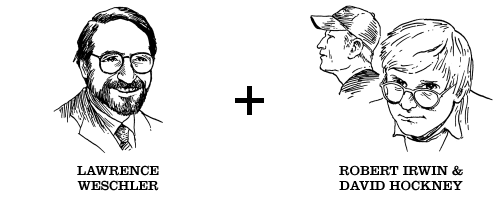Back in 1982, I published my first book, a midlife portrait of the California “light and space” artist Robert Irwin, entitled Seeing Is Forgetting the Name of the Thing One Sees, a title that paradoxically, in this instance, said it all. Which is to say that the book surveyed all the things that Robert Irwin, sequentially over a period of about two decades (1958–78), had had to bracket out of his practice—figure, image, line (which is to say, associations of any kind), focus, any made or permanent object, signature, and presently even exhibition itself—before he was able to arrive at what he’d come to comprehend as the true subject of art: the sheer wonder of perception itself, or, as he sometimes parsed matters, “all the marvel inherent in our perceiving ourselves perceiving.”
Shortly after that book’s publication I got a call from another artist famously associated with California, David Hockney, a painter I’d never met but one whose work I naturally knew well. He invited me up to the Hollywood Hills home into which he’d recently moved, and, after cordially offering me tea and making me feel quite at ease, he began by telling me he’d recently finished reading my book about Irwin, and though he disagreed with almost every single thing in it, still, he couldn’t get it out of his head, such that he thought it might be a good idea to discuss the thing with me.
“I’ve never met Irwin,” he noted, “though I’ve of course been quite aware of his work, as what artist, especially here in L.A., wouldn’t be?” Already then, Irwin was regarded as one of the most significant artists and thinkers on artistic practice anywhere in the country, at least among fellow artists (though his reputation was considerably less well established among the public at large); within a few months he would become the first visual artist to be awarded one of the MacArthur Foundation’s so-called genius grants. “I mean,” Hockney continued, “I’ve observed his progress, though at times that was by no means easy, and for the longest time I felt that his position on the photographing of his work”—a flat prohibition, as it happens (which is one of the principal reasons he was so much less well known among the public at large)—“was pretty preposterous, and somewhat fetishistic.” Irwin for his part accounted for that absolutist injunction by arguing that a photograph could capture everything that the work was not about (which is to say its image) and nothing that it was about (which is to say its presence), so why bother?
Hockney paused and took a drag on a cigarette before going on to confound me entirely: “The...
You have reached your article limit
Sign up for a digital subscription and continue reading all new issues, plus our entire archives, for just $1.50/month.
Already a subscriber? Sign in





